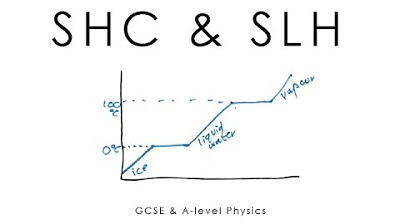Specific Heat of a Metal Lab
Summary
TLDRIn this educational video, the concept of specific heat is explored through an experiment to determine the specific heat capacity of cadmium metal. A 58.93-gram sample of cadmium is heated to 100°C and then placed into 100 grams of water at 22°C, within an insulated coffee cup calorimeter. The temperature of the water rises to 25°C, indicating a 3°C change. The goal is to calculate the specific heat of cadmium using the formula: heat quantity = mass x specific heat x temperature change.
Takeaways
- 🔍 The specific heat is defined as the amount of heat required to raise the temperature of one gram of a substance by 1°C.
- 💧 Water has a specific heat capacity of 4.184 joules per gram per Celsius degree.
- 🧊 The experiment aims to determine the specific heat of a cadmium metal sample.
- 📐 The mass of the cadmium sample is measured to be 58.93 grams.
- 🔥 The cadmium sample is heated to approximately 100°C.
- 🌡️ 100 milliliters of water at room temperature (22°C) is used, equivalent to 100 grams.
- ☕ The insulated coffee cup calorimeter is used to minimize heat loss.
- 🧪 It's assumed that the calorimeter gains no heat, and all the heat is transferred to the water.
- 📉 The temperature of the water increases to 25°C after the heated metal is added, indicating a 3°C temperature change.
- 🧮 The task is to calculate the specific heat of the cadmium using the formula: quantity of heat = mass × specific heat × change in temperature.
Q & A
What is specific heat capacity?
-Specific heat capacity is the amount of heat required to raise the temperature of one gram of a substance by 1°C.
What is the specific heat capacity of water?
-The specific heat capacity of water is 4.184 joules per gram per Celsius degree.
What is the mass of the cadmium metal sample used in the experiment?
-The mass of the cadmium metal sample is 58.93 grams.
What is the initial temperature of the water used in the experiment?
-The initial temperature of the water is room temperature, which is measured to be 22°C.
What is the final temperature of the water after the cadmium metal is added?
-The final temperature of the water after the cadmium metal is added is 25°C.
How much water is used in the experiment, and what is its equivalent in grams?
-100 milliliters of water is used, which is equivalent to 100 grams since 1 milliliter of water is approximately equal to 1 gram.
What is the temperature change of the water during the experiment?
-The temperature change of the water is 3°C, as it was initially at 22°C and increased to 25°C.
What is the initial temperature of the cadmium metal before it is placed in the water?
-The initial temperature of the cadmium metal is approximately 100°C, as it was heated to near boiling point.
What method is used to ensure that the metal and water reach the same temperature?
-The method used to ensure that the metal and water reach the same temperature is by swirling the metal in the water with a thermometer until the temperature stabilizes.
What is the purpose of using a coffee cup calorimeter in the experiment?
-A coffee cup calorimeter is used because it is insulated, helping to minimize heat loss to the surroundings and ensuring that the water gains all the energy given off by the metal.
How is the temperature change used to calculate the specific heat of the cadmium metal?
-The temperature change, along with the mass of the metal and the temperature change in the water, is used in the formula Q = mcΔT to calculate the specific heat of the cadmium metal.
Outlines

此内容仅限付费用户访问。 请升级后访问。
立即升级Mindmap

此内容仅限付费用户访问。 请升级后访问。
立即升级Keywords

此内容仅限付费用户访问。 请升级后访问。
立即升级Highlights

此内容仅限付费用户访问。 请升级后访问。
立即升级Transcripts

此内容仅限付费用户访问。 请升级后访问。
立即升级浏览更多相关视频
5.0 / 5 (0 votes)






